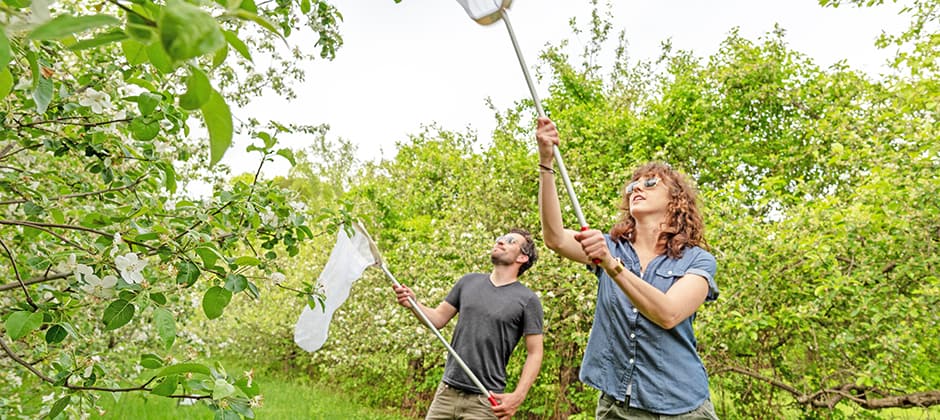Share this article
Honeybees spread viruses to wild bees through flowers
Just as doorknobs can spread the flu from one person to another, sharing flowers with honeybees may cause wild bumblebees to contract a pair of deadly viruses.
“We know that there’s been a number of declines in wild bumblebee species,” said Samantha Alger, a research affiliate in the plant and soil science department at the University of Vermont and a pollinator specialist at the VHB engineering firm. “There’s an overlap in foraging and a close species relationship between honeybees and wild bumblebees. Honeybees are a managed insect that we keep in dense populations and farm them as agriculture and livestock, and they’re a likely source for spreading pathogens to wild species.”
Alger led a study published in PLOS ONE looking at the presence of two RNA viruses on honeybees (Apis mellifera), wild bumblebees (Bombus spp.) and flowers, in order to determine if honeybee viruses were spilling over to wild bumblebees and if shared flowers may be a culprit.
She and her colleagues studied 19 sites around Vermont. Choosing locations with honeybee apiaries nearby, they collected bumblebees, honeybees and flowers within 300 meters of the apiaries and tested them for deformed wing virus and black queen cell virus — two viruses that had been found in bumblebees in the United Kingdom, but not in local populations. They then did the same thing 1 kilometer or farther from apiaries.
“The first question was, could we find the viruses in wild bees in Vermont?” Alger said.
Bumblebees not only tested positive for the viruses, researchers found, but they were significantly more likely to have the viruses when they were collected closer to honeybee apiaries. In sites without honeybees nearby, none of the wild bumblebees tested positive for deformed wing virus, a virus most associated with Varroa mites in honeybees.
What most surprised Alger most was the presence of the viruses on the flowers. “In the huge fields of blooming flowers, we thought we would be looking for a needle in a haystack,” she said. Instead, they found 19% of the flowers collected close to the apiaries had the viruses on them, but none of the flowers farther away had them.
The findings and patterns suggest that honeybee apiaries are a hotspot for virus transmission, Alger said. These viruses may be contributing to declines of wild bumblebee, like the federally listed rusty patched bumblebee (Bombus affinis), she said, although more research is necessary to determine this.
The good news is, changes in management can help stop the spread of viruses, Alger said. Because bees with Varroa mites are more likely to have higher virus loads, managers can manage for those mites, she said, but education is critical especially for new beekeepers, through local beekeeping associations and clubs as well as robust apiary inspection programs to help manage for Varroa mites.
A lot of people who want to save the bees get into beekeeping,” she said. “But the worst thing is to want to save the bees and get into beekeeping but not being educated on how to be a good beekeeper.”
Header Image: Samantha Alger and co-author Alex Burnham catch bees at a site in Vermont. After collecting honeybees, bumblebees and flowers, they found flowers might be a way honeybees pass viruses onto wild bumblebees. ©Joshua Brown/UVM








